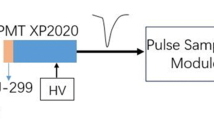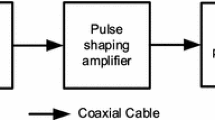Abstract
Introduction
Detecting a pulse correctly is a key process in nuclear detection. Because the radiation emission is a random process, it is hard to design a suitable peak-detection approach in FPGA. The error detection will influence the final energy spectrum and flood histogram. In order to improve the result of nuclear detection, this paper proposes a novel method for nuclear signal peak-detection, which can improve both the effective counting rate and the quality of pulses in real-time.
Methods
The main method is to establish a normalized reference pulse regardless of waveform through the least squares method. By calculating the loss between the incoming data stream and normalized reference pulse, this algorithm retains the pulses whose loss is below the threshold. We select the threshold based on statistical methods. The algorithm is implemented on field programmable gate array (FPGA) successfully, and this process is able to work in real-time.
Conclusion
The result shows that the effective counting rate can improve about 19.8% and more than 99% pile-up and error pulses will be suppressed. By analyzing reserved pulses, the energy spectrum and flood histogram could be well rectified. The energy resolution increases 11% compared with traditional algorithm. Furthermore, due to this new algorithm, the low-energy threshold can be lower.




















Similar content being viewed by others
References
L. Wielopolski, R.P. Gardner, Prediction of the pulse-height spectral distortion caused by the peak pile-up effect. Nucl. Instrum. Methods 133(2), 303–309 (1976)
L. Wielopolski, R.P. Gardner, A generalized method for correcting pulse-height spectra for the peak pile-up effect due to double sum pulses: Part II. The inverse calculation for obtaining true from observed spectra. Nucl. Instrum. Methods 140(2), 297–303 (1977)
S.L. Molodtsov, A.F. Gurbich, Simulation of pulse pile-up effect on the pulse- height spectrum. Nucl. Instrum. Methods Phys. Res. B 267, 3484–3487 (2009)
Q. Bristow, R.G. Harrison, Theoretical and experimental investigations of the distortion in radiation spectra caused by pulse pileup. Nucl. Geophys. 5(1–2), 141–186 (1991)
R.P. Gardner, S.H. Lee, Monte Carlo simulation of pulse pile up (JCPDS Int. Centre Diffr., Newtown Square, PA, 1999)
W. Guo, S.H. Lee, R.P. Gardner, The Monte Carlo approach MCPUT for correcting pile-up distorted pulse-height spectra. Nucl. Instrum. Methods Phys. Res. A 531, 520–529 (2004)
W. Guo, R.P. Gardner, F. Li, A Monte Carlo code for simulation of pulse pileup spectral distortion in pulse-height measurement. Int. Centre Diffr. Data (ICDD) Adv. X-ray Anal. 48, 246–252 (2005)
L. Sabbatucci, V. Scot, J.E. Fernández, Multi-shape pulse pile-up correction: the MCPPU code. Radiat. Phys. Chem. 104, 372–375 (2014)
L. Sabbatucci, V. Scot, J.E. Fernández, First principles pulse pile-up balance equation and fast deterministic solution. Radiat. Phys. Chem. 104, 12–17 (2017)
L. Sun, K. Zhuang, X. Wang et al., Design of readout electronics based on peak-holding circuit and multiplexer for a fast neutron spectrometer. Radiat. Detect. Technol. Methods 2(1), 6 (2018)
周魏. 博士论文-双平板乳腺 PET 电子学关键技术研究 (2016)
D. Harville, Extension of the Gauss–Markov theorem to include the estimation of random effects. Ann. Stat. 4(2), 384–395 (1976)
J. Volder, The CORDIC computing technique, in Papers Presented at the March, Western Joint Computer Conference (1959)
J.E. Volder, The CORDIC trigonometric computing technique. IRE Trans. Electron. Comput. EC-8(3), 330–334 (1959)
J.S. Walther. A unified algorithm for elementary functions, in Spring Joint Computer Conference. ACM (1971)
R. Andraka. A survey of CORDIC algorithms for FPGA based computers (1998)
X. Hu, R.G. Harber, S.C. Bass, Expanding the range of convergence of the CORDIC algorithm. IEEE Trans. Comput. 40(1), 13–21 (1991)
王强. 大面积位置灵敏探测器的研制. 成都理工大学 (2016)
Acknowledgements
This work is supported by the Instrument Developing Project of the Chinese Academy of Sciences Grant 29201707.
Author information
Authors and Affiliations
Corresponding author
Rights and permissions
About this article
Cite this article
Yang, Y., Li, D., Li, Y. et al. A real-time peak-detection approach for nuclear detection and its implementation on an FPGA. Radiat Detect Technol Methods 4, 161–173 (2020). https://doi.org/10.1007/s41605-020-00165-1
Received:
Revised:
Accepted:
Published:
Issue Date:
DOI: https://doi.org/10.1007/s41605-020-00165-1




